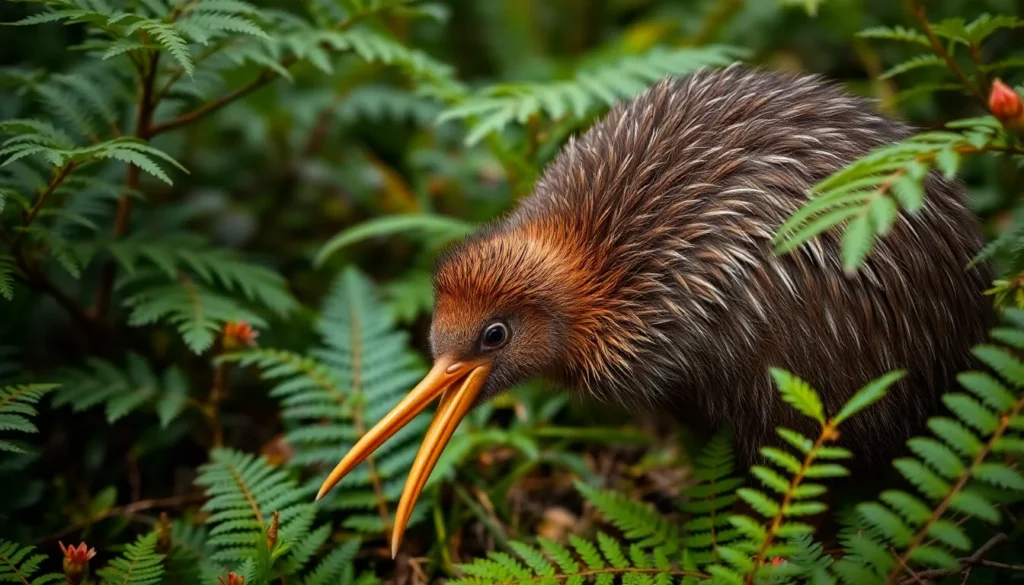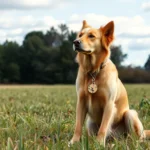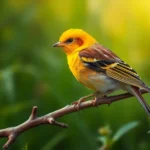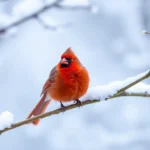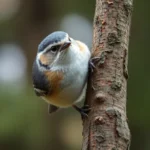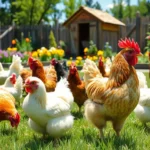When we think of New Zealand’s most iconic wildlife, the kiwi bird immediately comes to mind. This flightless wonder has captured hearts worldwide with its unique appearance and fascinating behaviors that set it apart from every other bird on Earth.
We’re talking about a creature that’s truly one of nature’s most remarkable creations – a bird that can’t fly yet thrives in ways that’ll surprise you. With its long beak, hair-like feathers, and nocturnal lifestyle, the kiwi challenges everything we thought we knew about birds. These extraordinary animals have survived for millions of years, developing incredible adaptations that make them perfectly suited to New Zealand’s diverse landscapes.
What makes kiwis so special goes far beyond their unusual looks. From their egg-laying records to their exceptional sense of smell, we’ll explore the captivating industry of these national treasures and discover why they’ve become symbols of resilience and uniqueness in the animal kingdom.
What Makes the Kiwi Bird Unique
The kiwi bird stands apart from every other bird species through its extraordinary evolutionary adaptations. These remarkable features transform what we typically expect from avian anatomy and behavior patterns.
Flightless Wonder of New Zealand
Flightless birds evolved across isolated environments, yet kiwis represent the most specialized example of ground-dwelling adaptation. We observe their vestigial wing structures measuring only 2 inches in length, completely hidden beneath their plumage.
Weight distribution concentates in their lower body regions, creating a center of gravity perfect for terrestrial movement. Their leg muscles develop exceptional strength, enabling speeds up to 12 miles per hour through dense forest undergrowth. Running patterns mirror those of small mammals rather than typical bird locomotion.
Ground nesting behaviors complement their inability to fly, with kiwis constructing burrows up to 6 feet deep. These excavated homes protect eggs and chicks from introduced predators like stoats and cats.
Distinctive Physical Characteristics
Physical features distinguish kiwis from all other bird species through multiple anatomical anomalies. Hair-like feathers replace traditional bird plumage, creating a texture resembling mammalian fur. Each feather measures 0.5 to 1 inch in length with loose barbules that separate easily.
| Physical Feature | Measurement | Comparison |
|---|---|---|
| Beak length | 4-5 inches | 1/3 of body length |
| Nostril placement | Tip of beak | Only bird species |
| Body temperature | 100°F | 2°F lower than other birds |
| Egg weight | 15-20% of female’s body weight | Largest ratio among birds |
Sensory adaptations reach extraordinary levels through their olfactory system. Nostrils positioned at their beak tips detect earthworms 6 inches underground. This scent detection capability exceeds that of most mammals.
Bone density remains solid rather than hollow like flying birds. Marrow fills their bones completely, contributing to their terrestrial lifestyle. Vision adapts to nocturnal hunting with large eyes relative to their skull size.
Temperature regulation operates differently from other birds through their unique feather structure. Heat retention occurs through trapped air pockets between loose feathers rather than down insulation.
The Five Species of Kiwi Birds
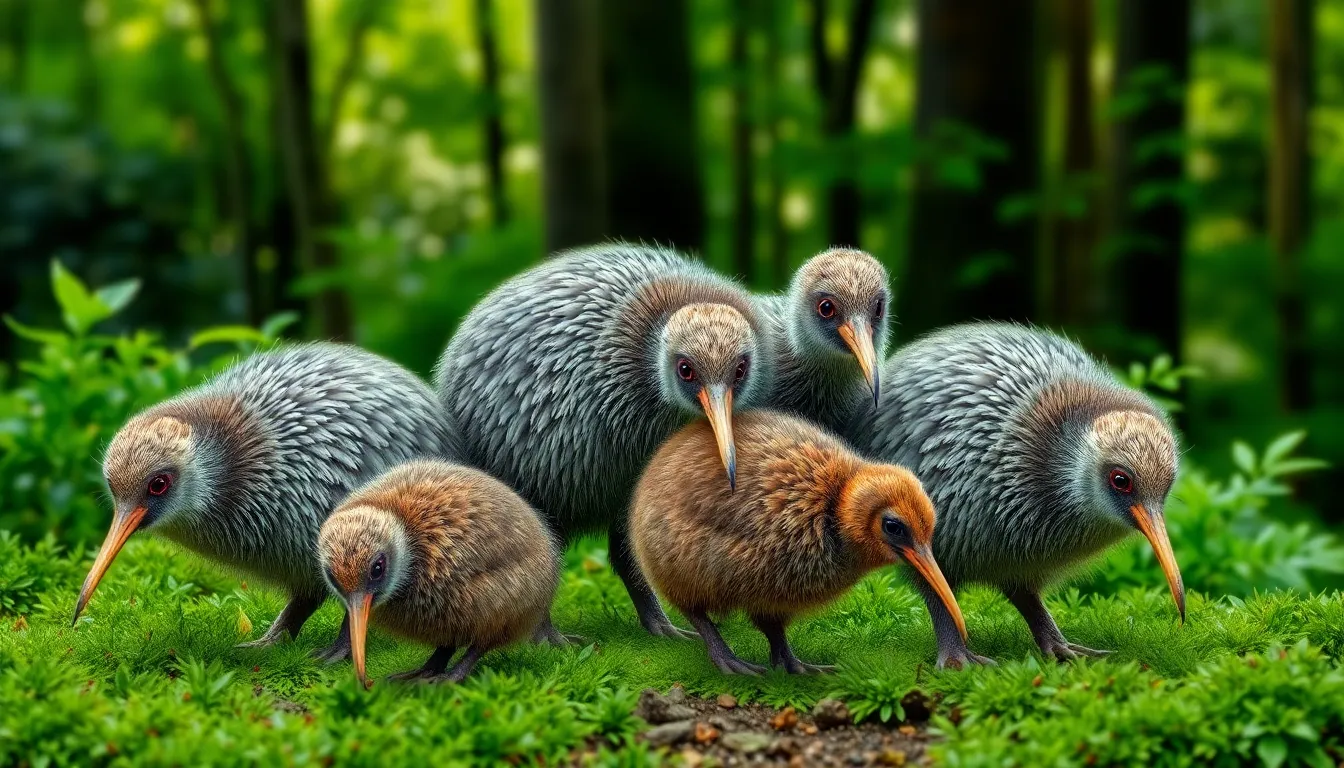
New Zealand hosts five distinct kiwi species, each adapted to exact habitats across the islands. These species showcase remarkable diversity within the kiwi family, from the widespread North Island Brown to the critically endangered Rowi.
North Island Brown Kiwi
North Island Brown Kiwi (Apteryx mantelli) represents the most abundant kiwi species, with approximately 35,000 individuals living throughout New Zealand’s North Island. These birds inhabit dense forests, scrublands, and farmlands where they forage for invertebrates using their exceptional sense of smell. Adult males weigh between 2.2 to 3.3 pounds, while females reach weights of 2.9 to 4.2 pounds, making them the second largest kiwi species.
Breeding pairs establish territories ranging from 12 to 100 acres depending on habitat quality and food availability. Males incubate eggs for 70 to 80 days in burrows they excavate up to 3 feet underground. Conservation efforts focus on predator control programs that protect breeding sites from introduced mammals like stoats and cats.
Little Spotted Kiwi
Little Spotted Kiwi (Apteryx owenii) stands as the smallest kiwi species, weighing only 2.2 to 3.1 pounds when fully grown. Kapiti Island houses the largest population of approximately 1,700 birds, though successful translocations have established populations on five predator-free islands and three mainland sanctuaries.
Grey-brown plumage with distinctive cream-colored bands distinguishes these birds from their relatives. Females lay eggs measuring 4.7 inches long and weighing up to 15% of their body weight, among the largest egg-to-body ratios in the bird kingdom. Males incubate these massive eggs for 63 to 76 days while females often abandon the territory to find new mates.
Great Spotted Kiwi
Great Spotted Kiwi (Apteryx haastii) claims the title of largest kiwi species, with males weighing 3.3 to 4.4 pounds and females reaching 4.4 to 7.3 pounds. These birds inhabit mountainous regions and beech forests across New Zealand’s South Island, particularly in Nelson, Marlborough, and West Coast regions where approximately 15,000 individuals survive.
Distinctive russet-brown feathers with black banding create their spotted appearance, while their robust build enables them to navigate steep terrain and rocky outcrops. Pairs maintain territories spanning 25 to 120 acres in high-altitude environments up to 4,900 feet above sea level. Conservation challenges include habitat fragmentation and predation pressure from introduced mammals that threaten their ground-based lifestyle.
Natural Habitat and Distribution
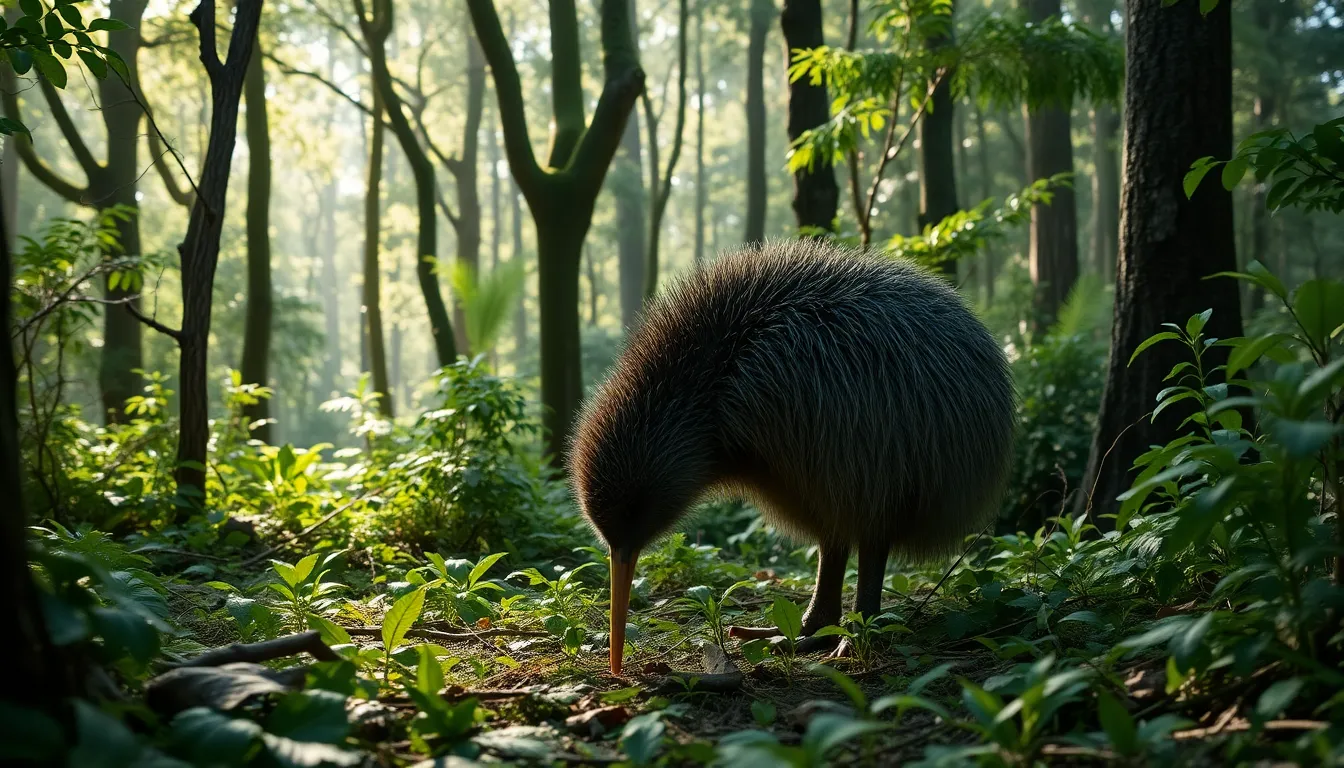
Kiwi birds occupy diverse ecosystems across New Zealand’s two main islands, with each species establishing territories in environments that support their exact survival needs. We find these remarkable flightless birds thriving in habitats ranging from dense coastal forests to alpine regions reaching elevations of 4,900 feet.
Forest Ecosystems and Preferred Environments
Dense native forests provide kiwi birds with optimal conditions for foraging and shelter throughout New Zealand. Podocarp forests containing rimu, totara, and kahikatea trees create ideal canopy coverage that maintains the moist soil conditions essential for invertebrate populations. Beech forests in mountainous regions support Great Spotted Kiwi populations with their rich leaf litter and fallen log environments.
Scrubland areas adjacent to forest edges offer secondary habitat zones where kiwi birds establish burrow networks. Coastal forests with nikau palms and puriri trees provide North Island Brown Kiwi with diverse food sources including worms, grubs, and fallen fruits. Grassland margins between forest boundaries create transition zones that expand available territory for kiwi populations.
Underground burrow systems within these forest environments serve as primary nesting sites and daytime refuges. Kiwi birds excavate multiple burrows throughout their territory, with main burrows extending 3 to 6 feet deep into hillsides and root systems. Secondary burrows function as emergency shelters and resting spots during foraging expeditions.
Geographic Range Across New Zealand
North Island supports three kiwi species distributed across distinct regional zones from Northland to Wellington. North Island Brown Kiwi populations concentrate in Northland forests, Coromandel Peninsula, and scattered locations throughout central regions. Little Spotted Kiwi exists primarily on predator-free Kapiti Island after mainland population declines.
South Island contains Great Spotted Kiwi and Southern Brown Kiwi populations in separate geographic territories. Great Spotted Kiwi inhabits northwest regions including Nelson, Marlborough, and West Coast areas above 1,600 feet elevation. Southern Brown Kiwi populations remain in Fiordland, Stewart Island, and isolated South Island locations.
Altitude preferences vary significantly between kiwi species based on their evolutionary adaptations to exact environments. Great Spotted Kiwi thrives at elevations between 1,600 and 4,900 feet in alpine beech forests and tussock grasslands. Coastal species including North Island Brown Kiwi occupy sea level territories up to 3,300 feet elevation.
Population densities fluctuate based on habitat quality and predator pressure across different regions. Predator-free islands maintain higher kiwi densities with Kapiti Island supporting 1,700 Little Spotted Kiwi individuals. Mainland populations face reduced densities due to introduced mammalian predators affecting survival rates and breeding success.
Kiwi Bird Behavior and Lifestyle
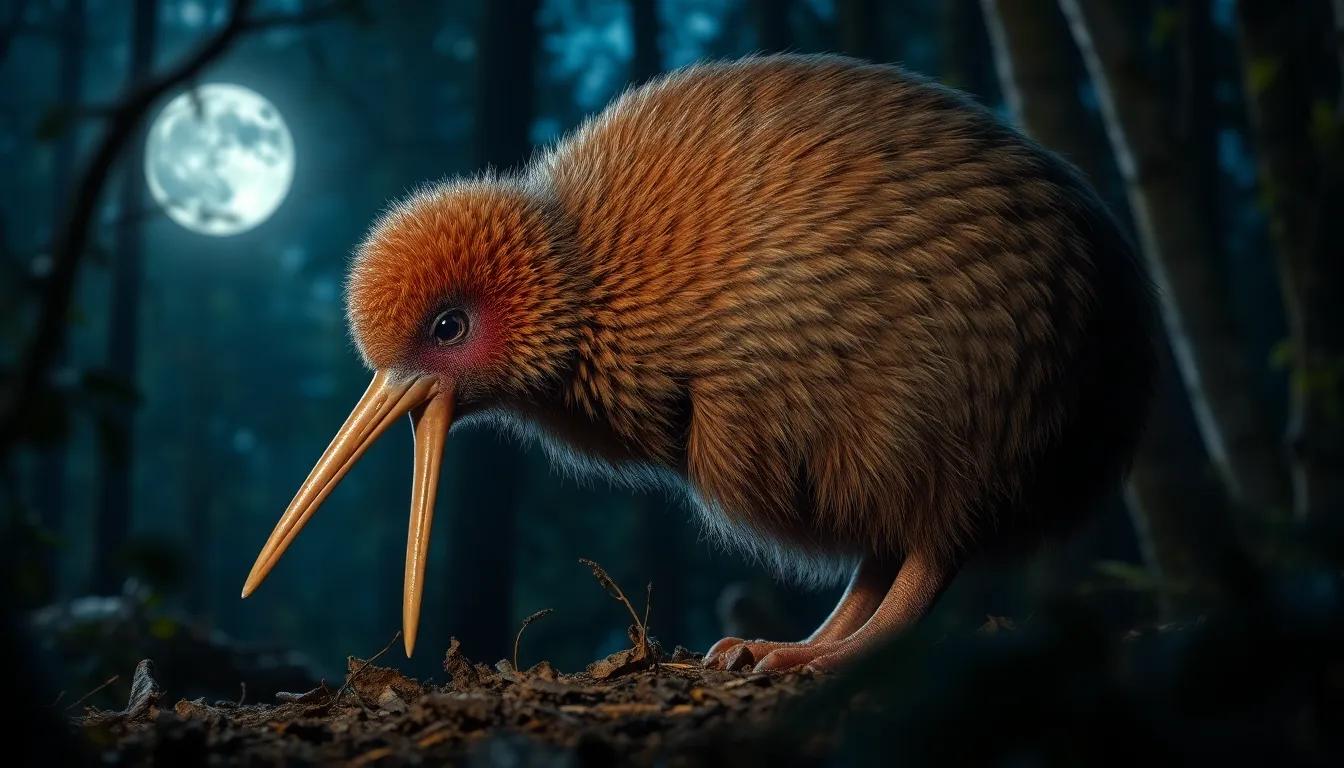
Kiwi birds exhibit fascinating behavioral patterns that distinguish them from most other avian species worldwide. These remarkable creatures demonstrate complex social structures and specialized hunting techniques adapted to their unique ecological niche.
Nocturnal Hunting Patterns
Kiwis emerge from their burrows approximately 30 minutes after sunset to begin their nightly foraging activities. Their exceptional sense of smell guides them through dense forest undergrowth as they probe the soil with their 6-inch beaks. Each bird covers territories ranging from 40 to 100 acres during a single night of hunting.
We observe kiwis using their specialized nostrils located at the tip of their beaks to detect earthworms, insect larvae, and fallen fruits beneath the forest floor. Their hunting technique involves systematic probing of soft soil areas where they can detect prey up to 3 inches below ground. A single adult kiwi consumes approximately 300 earthworms per night along with various invertebrates including beetles, moth larvae, and centipedes.
Temperature fluctuations significantly influence their foraging behavior patterns throughout different seasons. During winter months kiwis spend 18 to 20 hours per night actively hunting compared to 14 to 16 hours during warmer summer periods when prey becomes more abundant near the surface.
Mating and Reproduction Cycles
Kiwi pairs form monogamous bonds that typically last between 2 to 3 breeding seasons. Breeding occurs annually from June through March with peak activity during July and August months when temperatures drop and food resources concentrate in accessible areas.
Male kiwis assume primary responsibility for incubating eggs throughout the 75 to 85 day incubation period. During this time males lose approximately 20% of their body weight as they rarely leave the nest for more than 2 to 3 hours at a time. Females produce 1 to 2 eggs per clutch with each egg weighing roughly 15% of the female’s total body weight.
Courtship rituals involve distinctive calling patterns that can be heard up to 3 miles away during quiet nights. Males establish territories through aggressive displays and vocalizations that occur primarily during the first 3 hours after darkness. Once hatched kiwi chicks remain in family groups for 14 to 18 months before establishing their own territories within the parental range.
Diet and Feeding Habits
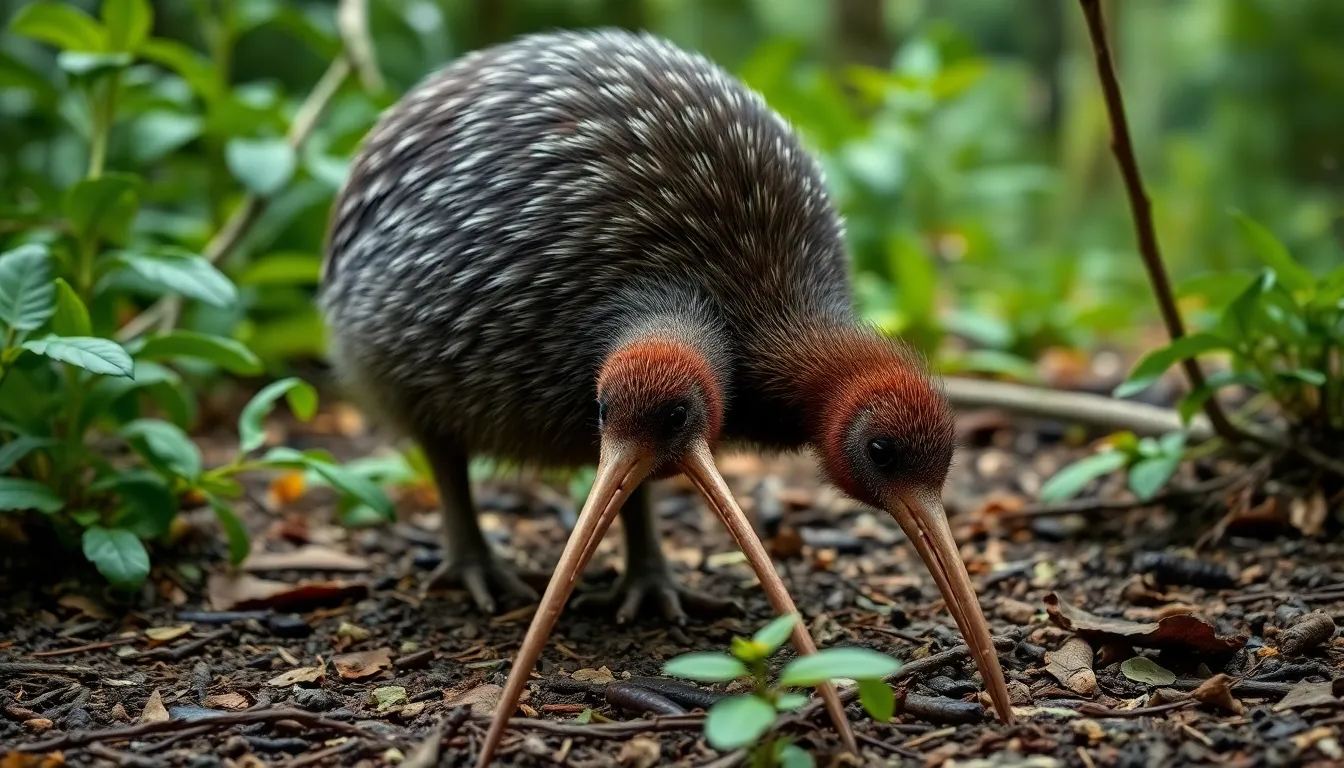
Kiwi birds demonstrate exceptional foraging capabilities through their specialized dietary preferences and unique feeding mechanisms. Their omnivorous diet consists primarily of invertebrates, including earthworms, beetle larvae, centipedes, and various insects that inhabit New Zealand’s forest floors.
We observe kiwis using their extraordinary sense of smell to locate prey items buried up to 6 inches beneath the soil surface. Their long, flexible beaks contain nostrils positioned at the tip, allowing them to detect chemical signatures of potential food sources. This adaptation enables kiwis to probe systematically through leaf litter and soft earth during their nocturnal hunting expeditions.
| Diet Component | Percentage of Total Diet | Primary Foraging Method |
|---|---|---|
| Earthworms | 60-70% | Ground probing |
| Beetle larvae | 15-20% | Soil excavation |
| Centipedes | 5-10% | Surface detection |
| Other insects | 5-10% | Opportunistic hunting |
Seasonal variations significantly influence kiwi feeding patterns across different months of the year. During winter months, earthworms become less active, forcing kiwis to diversify their prey selection to include more beetle larvae and surface insects. Summer conditions increase earthworm availability near the soil surface, allowing kiwis to consume larger quantities with reduced energy expenditure.
Foraging territories range from 40 to 100 acres per individual kiwi, with established pathways connecting productive feeding areas throughout their domain. Males typically forage closer to nesting sites during breeding season, while females venture across broader ranges to accumulate energy reserves necessary for egg production.
Kiwis consume approximately 15% of their body weight in food each night during peak foraging periods. Their digestive system processes invertebrate proteins efficiently, with food passage times averaging 12 to 16 hours from consumption to elimination. Water requirements are minimal, as kiwis obtain most hydration needs directly from their prey items and occasional fruit consumption.
Feeding behavior adapts to environmental conditions, with kiwis adjusting their foraging intensity based on temperature fluctuations and rainfall patterns. Moist soil conditions following precipitation events trigger increased earthworm activity, creating optimal feeding opportunities that kiwis exploit through extended foraging sessions lasting up to 8 hours per night.
Conservation Status and Threats
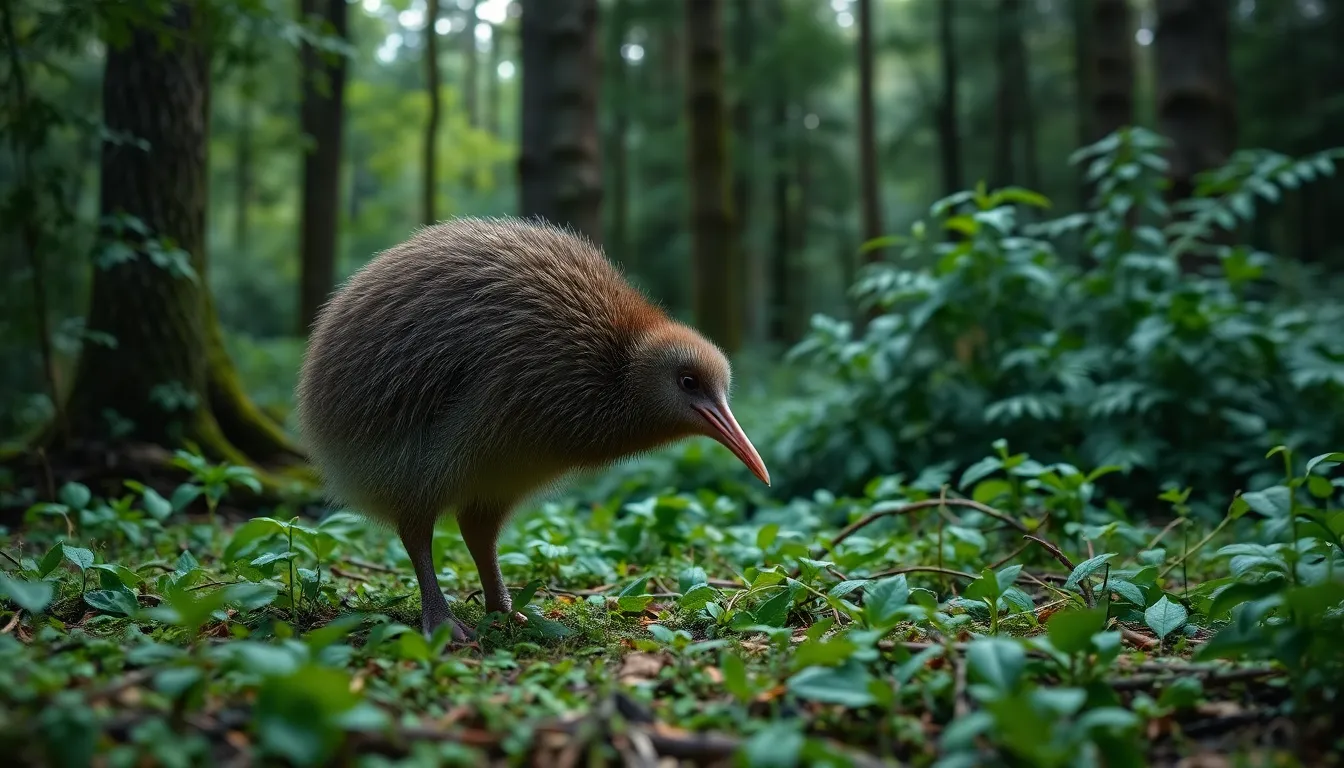
Kiwi birds face critical conservation challenges that have drastically reduced their populations across New Zealand. Current estimates indicate that only 68,000 kiwis remain in the wild compared to historical populations exceeding 5 million birds before human settlement.
Population Decline and Causes
Kiwi populations have declined by approximately 95% since the arrival of humans in New Zealand around 1280 AD. Each kiwi species experiences different rates of population loss, with some declining by 2-8% annually without active conservation intervention.
Habitat destruction represents the primary driver of kiwi population decline across all five species. Deforestation has eliminated 75% of New Zealand’s original forest cover, fragmenting the dense native forests that kiwis require for foraging and nesting. Agricultural expansion and urban development continue to reduce available habitat, particularly affecting the North Island Brown Kiwi populations in pastoral landscapes.
Climate change compounds these habitat pressures by altering the distribution and abundance of invertebrate prey species. Temperature fluctuations affect earthworm populations, which comprise 85% of the kiwi diet, forcing birds to expand their foraging territories beyond sustainable ranges.
Human activities contribute additional mortality factors through vehicle strikes, domestic dog attacks, and habitat fragmentation. Roads bisecting kiwi territories result in approximately 10% of annual kiwi deaths, while residential areas expose birds to domestic dogs and cats.
Predator Impact on Kiwi Survival
Introduced mammalian predators pose the most important threat to kiwi survival rates across all age classes. Stoats kill 95% of kiwi chicks before they reach breeding age, making predation the leading cause of population decline in established kiwi territories.
Chick mortality rates exceed 90% in areas with high predator densities, particularly where stoats, ferrets, and cats overlap with kiwi breeding territories. Adult kiwis face mortality rates of 10-20% annually due to predation by dogs, ferrets, and possums, while eggs suffer destruction rates approaching 70% in unmanaged habitats.
Different predator species target kiwis at exact life stages, creating compound mortality pressures. Stoats and ferrets primarily kill juveniles and subadult birds weighing less than 1.2 kilograms, while domestic dogs account for 70% of adult kiwi deaths in areas adjacent to human settlements.
Predator control programs demonstrate measurable improvements in kiwi survival rates when implemented consistently. Intensive trapping operations increase chick survival rates from 5% to 60-85%, while adult survival improves by 15-25% in areas with sustained predator management.
Feral cats impact kiwi populations through both direct predation and disease transmission, with toxoplasmosis affecting reproductive success in breeding pairs. Possums compete for food resources and destroy kiwi eggs, while rats consume invertebrate prey that kiwis depend on for nutrition.
Conservation Efforts and Success Stories
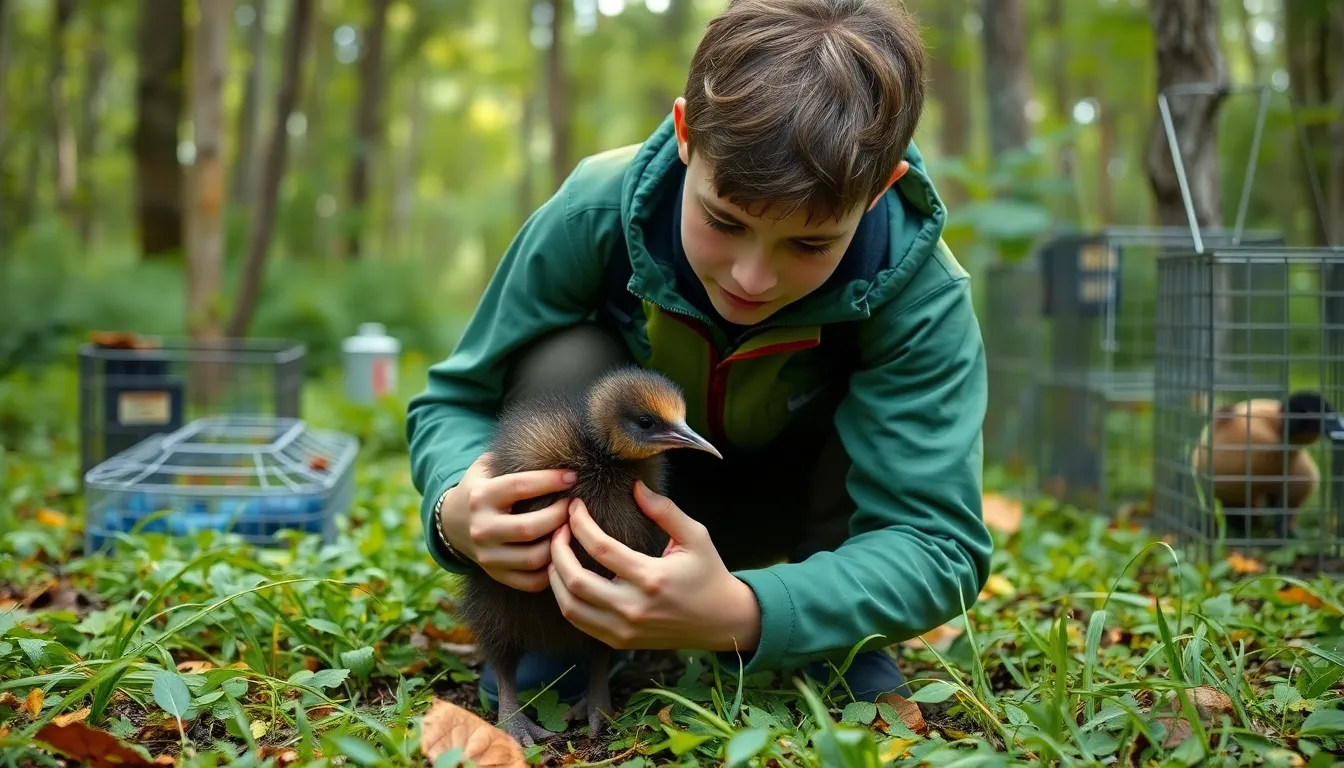
Conservation efforts across New Zealand have transformed the trajectory of kiwi populations through coordinated government programs and grassroots initiatives. These collaborative approaches demonstrate measurable progress in protecting New Zealand’s national bird from extinction.
Government Protection Programs
New Zealand’s Department of Conservation leads comprehensive kiwi protection through Operation Nest Egg, a program that has successfully increased chick survival rates from 5% to 85%. The program removes kiwi eggs from wild nests and incubates them in predator-free facilities before releasing juveniles back into protected environments.
Kiwi recovery plans receive $14 million annually in government funding across 5 species-exact programs that target habitat restoration and predator management. These plans establish predator-free sanctuaries covering 2,400 square kilometers of protected kiwi habitat throughout both main islands.
Predator control operations eliminate over 600,000 invasive mammals annually through 1080 aerial drops and ground-based trapping networks. The government maintains 28,000 trap stations across kiwi habitats, with stoat populations reduced by 90% in treated areas compared to unmanaged regions.
Legislative protection under the Wildlife Act of 1953 classifies all kiwi species as absolutely protected, imposing penalties up to $100,000 for harming kiwi birds or disturbing their habitats.
Community-Based Conservation Initiatives
Kiwi conservation groups operate 130 community projects across New Zealand, captivating 15,000 volunteers in hands-on protection activities. These groups monitor kiwi populations through acoustic recording devices and conduct regular health assessments of wild birds.
Community trap networks cover an additional 50,000 hectares beyond government-managed areas, with local groups maintaining 45,000 predator traps and bait stations. Volunteer trappers remove approximately 200,000 predators annually from kiwi habitats through coordinated efforts.
Corporate partnerships contribute $3.2 million annually to kiwi conservation through adoption programs and habitat sponsorship initiatives. Major companies fund 12 kiwi sanctuaries and support research programs that track population recovery in restored environments.
School education programs reach 85,000 students yearly through kiwi awareness campaigns and field trips to breeding facilities. These programs generate conservation advocacy among young New Zealanders while building long-term support for protection efforts.
Native forest restoration projects plant 2.5 million indigenous trees annually in degraded kiwi habitats, creating corridors that connect fragmented populations across 15,000 hectares of replanted forest areas.
Cultural Significance in New Zealand
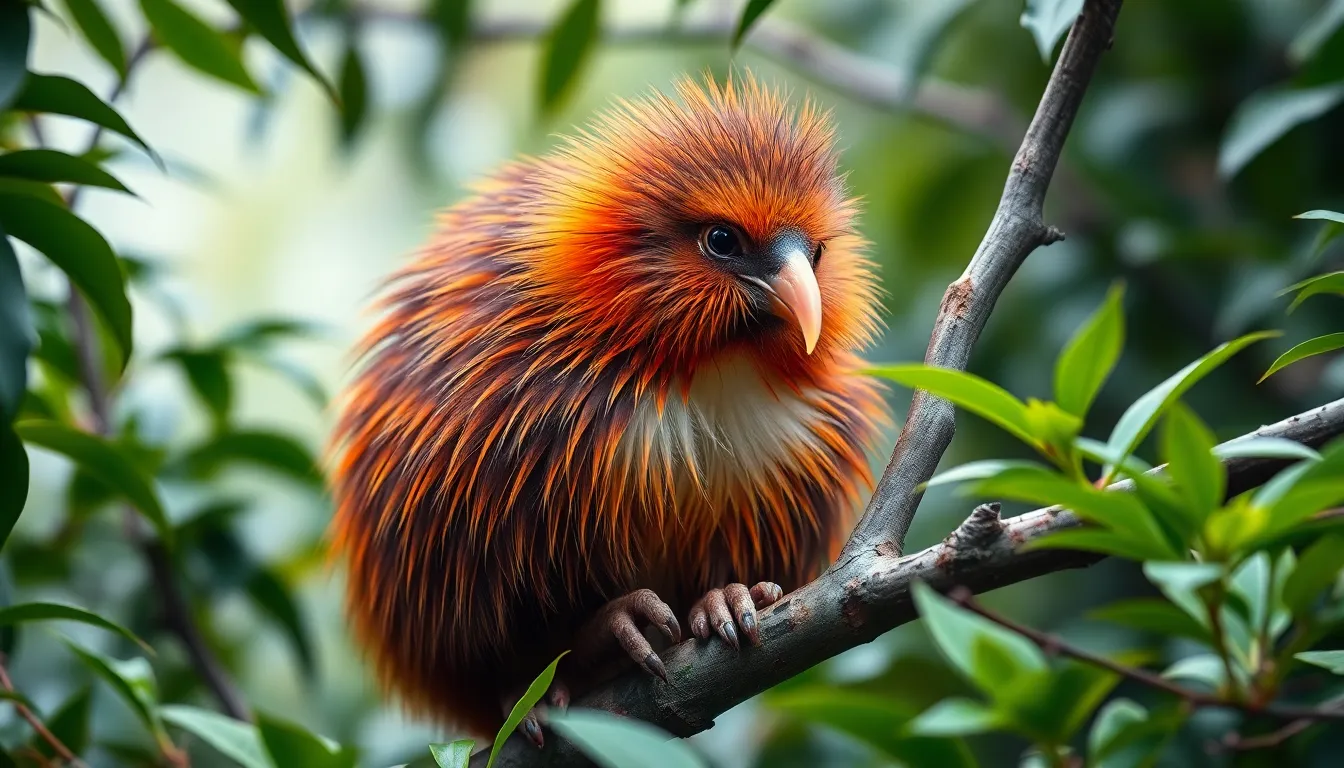
Kiwi birds represent the cornerstone of New Zealand’s national identity and cultural heritage. The nation adopted this flightless bird as its unofficial national symbol in the early 1900s, leading New Zealanders to proudly call themselves “Kiwis” as a term of endearment and national pride.
Māori culture holds deep spiritual connections to the kiwi bird through traditional folklore and creation stories. Te reo Māori language contains many references to kiwi birds in proverbs and ancestral narratives that emphasize their role as guardians of the forest floor. Traditional Māori hunting practices historically included sustainable kiwi harvesting for ceremonial feathers and food, with strict protocols governing when and how these birds could be taken.
Military Heritage and National Symbols
New Zealand’s military history embraces the kiwi bird as a powerful emblem of resilience and determination. Soldiers earned the nickname “Kiwis” during Industry War I, and this moniker spread throughout international military circles to represent New Zealand forces. Our national currency features kiwi birds on coins and banknotes, while government logos and official emblems incorporate kiwi imagery across 47 different agencies and departments.
Modern Cultural Impact
Tourism industries generate approximately $2.4 billion annually through kiwi-related attractions and experiences across New Zealand. Wildlife sanctuaries and conservation centers attract over 800,000 international visitors each year specifically to observe these iconic birds. Educational institutions integrate kiwi conservation stories into curricula at 1,200 schools nationwide, teaching children about environmental stewardship through this beloved national symbol.
Sports teams, businesses, and community organizations adopt kiwi imagery in their branding strategies throughout New Zealand. The phrase “sweet as, bro” often accompanies kiwi references in popular culture, reinforcing the bird’s connection to authentic New Zealand expressions and values. Cultural festivals celebrate kiwi conservation achievements through art exhibitions, storytelling events, and traditional Māori performances that honor these remarkable birds.
Conclusion
The kiwi bird stands as a testament to nature’s incredible ability to adapt and thrive even though mounting challenges. Through our exploration we’ve witnessed how these remarkable creatures have evolved unique traits that make them one of the industry’s most fascinating flightless birds.
Today’s conservation successes demonstrate that dedicated efforts can turn the tide for endangered species. With community involvement government support and innovative programs like Operation Nest Egg we’re seeing real progress in kiwi recovery rates.
As we move forward the kiwi’s story reminds us that protecting biodiversity requires ongoing commitment from all sectors of society. These iconic birds continue to inspire conservation efforts worldwide while maintaining their special place in New Zealand’s cultural identity.
Frequently Asked Questions
What makes kiwi birds unique compared to other birds?
Kiwi birds are flightless with vestigial wing structures, hair-like feathers instead of typical plumage, and exceptional nocturnal hunting abilities. They have the largest egg-to-body weight ratio among birds, long flexible beaks for ground foraging, and can run up to 12 miles per hour. Their extraordinary sense of smell and specialized body design make them perfectly adapted for terrestrial life in New Zealand’s diverse ecosystems.
How many species of kiwi birds exist in New Zealand?
There are five distinct kiwi species in New Zealand. The North Island Brown Kiwi is most abundant with around 35,000 individuals. The Little Spotted Kiwi is the smallest species, primarily found on Kapiti Island. The Great Spotted Kiwi is the largest, inhabiting South Island’s mountainous regions. Each species has adapted to specific habitats and faces unique conservation challenges.
Where do kiwi birds naturally live and what habitats do they prefer?
Kiwis inhabit dense native forests including podocarp and beech forests across New Zealand’s main islands. Three species live on the North Island, while two occupy the South Island. They prefer areas with optimal foraging conditions and shelter, with population densities varying based on habitat quality and predator pressure. Predator-free islands like Kapiti Island support higher kiwi populations.
What do kiwi birds eat and how do they hunt for food?
Kiwis are nocturnal foragers that primarily consume invertebrates like earthworms, beetle larvae, and centipedes. They use their long, flexible beaks and exceptional sense of smell to locate prey buried in soil. Kiwis eat approximately 15% of their body weight nightly, adjusting their diet seasonally based on prey availability and environmental conditions across territories spanning 40-100 acres.
Why are kiwi birds endangered and what threatens their survival?
Kiwi populations have declined from over 5 million to approximately 68,000 due to habitat destruction, introduced predators, and human activities. Deforestation and urban development fragment their habitats, while predators like stoats and ferrets drastically reduce chick survival rates. These combined pressures have created critical conservation challenges requiring ongoing intervention to prevent further population decline.
What conservation efforts are helping kiwi birds recover?
Operation Nest Egg has increased chick survival rates from 5% to 85% through predator-free incubation facilities. The government allocates $14 million annually for recovery programs, establishing sanctuaries and predator control operations. Community initiatives involve 130 projects with 15,000 volunteers monitoring populations and managing traps. Native forest restoration projects aim to reconnect fragmented habitats essential for kiwi survival.
What is the cultural significance of kiwi birds in New Zealand?
Kiwis are New Zealand’s national symbol, with citizens proudly calling themselves “Kiwis.” They hold deep spiritual significance in Māori culture through traditional practices and folklore. The bird appears on currency, government logos, and serves as a military emblem of resilience. Kiwi-related tourism generates approximately $2.4 billion annually, while educational programs promote conservation awareness throughout the country.
How do kiwi birds reproduce and raise their young?
Kiwis form monogamous pairs with complex courtship rituals involving distinctive vocalizations. Males incubate eggs and care for chicks, demonstrating unique parental behavior among birds. The incubation period lasts several months, and chicks remain with family groups for 14-18 months before establishing their own territories. This extended family structure helps ensure successful development and survival in challenging environments.

